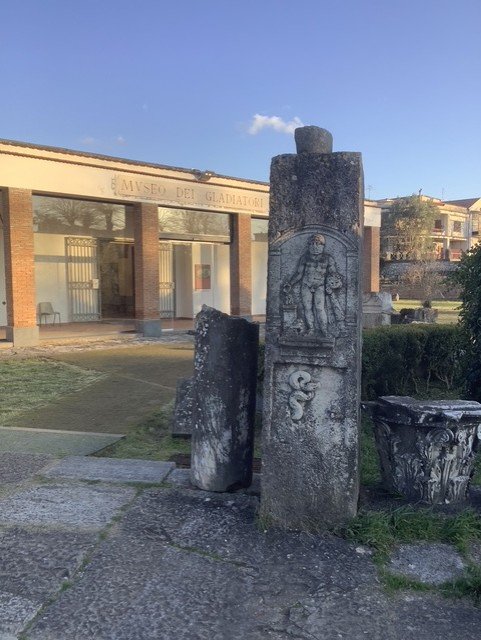XXXIX and XL Capua
What3words – i. trousers.flow.picked
- ii. erupted.friday.grape
Construction - i. 100AD ii. 30BC
Capacity - i. 60,000 ii. 25,000
Visited January 2025
Status – Although ravaged by quarrying, what remains is stunning. A World Heritage Site and home to the legend of Spartacus.
The Capua Amphitheatre is something special. What remains are the depleted and quarried ruins of one of the biggest and most elaborate Imperial structures. On a cloudless sunny January afternoon I was one of three visitors who paid €10 and was left free to wander the arena and the subterranean vaults. There is a small but perfectly presented museum containing Gladiatorial helmets, a model reconstruction of the great arena and some beautiful marble fixtures and fittings (A lot more of these can be found in the Naples Archaeaology museum). Beside the main entrance approach on the left, you can see the remains of the older, smaller Republican amphitheatre rising from the ground like the rib bones of a plesiosaur in a Dorset cliff face. This was where Spartacus is believed to have trained and fought before leading a rebellion.
Whilst the later Via Domitiana hugs the coastline between Rome and Naples, the Via Appia (now less romantically named route SS7) turns inland from Formia and Minturno and heads south-east towards the river crossing of the Volturno at Capua. The Roman Bridge survives to this day. Capua is home to the second largest Amphitheatre of the Roman Empire. Capua was founded on the site of an Etruscan city in the marshes of the river valley, after the Battle of Actium in 31BC. The earlier Republican arena was replaced by the new Amphitheatre behind a 46m high external curtain wall standing on 80 arches. Work began around 100AD and the resulting structure is believed to be the model for the subsequent, and even larger Colosseum, which also has 80 arches. It had an estimated seating capacity of more than 60,000. It is recorded as having been restored and augmented under Hadrian in 119AD with the addition of statues and columns. Emperor Antinious Pius inaugurated it in AD 155.
Thanks to Plutarch, Kirk Douglas, Stanley Kubrick and Karl Marx among others, a Thracian deserter from the Roman Army who was captured and trained as a Murmillo Gladiator, before leading a rebellion against republican Rome, is immortalised as a hero of oppressed and enslaved people. The revolt of Spartacus began in 73 BC when he, along with about 70 others, escaped from a gladiatorial school near Capua. Despite their small number, Spartacus's slave army defeated several Roman military units, and grew to an estimated 70,000 before defeat at the hands of Crassus (Laurence Olivier) and mass crucifixion. The Gladiator school and Spartacus are associated with the older amphitheatre, some remains of which are visible beside the entrance pathway to the newer structure.
As the Roman empire dissolved and Italy was invaded by Goths, Byzantine Greeks and Lombards, Capua suffered, and was finally almost totally destroyed by Saracen invaders in 841 AD. The inhabitants retreated a few miles north to a defensible position, surrounded on three sides by a bend of the Volturno river. They took with them many thousands of tonnes of marble and other masonry quarried from the amphitheatre. The location of what survives is now called Santa Maria Capua Vetere. Public buildings and churches in the medieval ‘new’ town display marble statuary taken from the great amphitheatre. This includes ornamental busts that were originally keystones in the arches of the curtain wall. Some of them still adorn the façade of the Palazzo del commune. The quarrying was finally brought to a close at the end of the 1700s when Bourbon rulers of the Kingdom of Naples took an interest in archaeological history.
Visible foundations of the earlier Amphitheatre
Hercules displays his Marbles outside the Museum of Gladiators
A Marble Keystone
Model Reconstruction
Model Reconstruction - The Outer Curtain Wall
Marble relief depicting a Beast Hunt
Murmillo Helmets





















